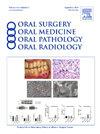远端转移到下颌腺-谁,何时和什么
IF 1.9
3区 医学
Q2 DENTISTRY, ORAL SURGERY & MEDICINE
Oral Surgery Oral Medicine Oral Pathology Oral Radiology
Pub Date : 2025-07-21
DOI:10.1016/j.oooo.2025.04.015
引用次数: 0
摘要
转移到唾液腺的肿瘤主要来源于头颈部的鳞状细胞癌,其次是黑色素瘤,占所有唾液腺肿瘤的5%。在本研究中,我们报告了一例转移性肾细胞癌到颌下腺实质,旨在探讨颌下腺转移性肿瘤的特征。材料和方法通过PubMed、MEsH和PMC数据库进行在线检索。纳入的研究和病例报告显示,非头颈癌转移到下颌腺。结果共发现42例颌下腺转移。大多数(13例,30.9%)起源于原发性肾肿瘤,其次是肺肿瘤(7例,16.6%)和乳腺肿瘤(6例,14.2%)。女性偏好较强,F:M比例为1.8:1。平均年龄60.7岁以上,28 ~ 97岁。26例(61.9%)患者行病变腺体切除治疗。26例(61.9%)有随访生存数据,治疗后平均生存19.48个月以上。10例(23.8%)患者的下颌转移是恶性肿瘤的首发征象,25例(59.5%)患者诊断为转移性疾病的首发征象。24例(57.1%)患者报告了额外的转移,4例(9.5%)患者表现为单独的下颌下转移,其余14例(33.3%)患者没有额外转移的数据。结论颌下腺转移性肿瘤较为少见。有一个不可忽视的百分比的病例,这些转移是一个未确诊的远端恶性肿瘤和/或未确诊的转移性疾病的第一个迹象。本文章由计算机程序翻译,如有差异,请以英文原文为准。
Distant metastases to the submandibular gland—WHO, WHEN and WHAT
Introduction
Metastases to the salivary glands mostly originate from squamous cell carcinomas of the head and neck region, followed by melanomas, and they comprise 5% of all salivary gland tumors. In this study, we present a case of metastatic renal cell carcinoma to the submandibular gland parenchyma and aim at characterizing metastatic tumors of the submandibular gland.
Materials and methods
An online search was conducted through the PubMed, MEsH, and PMC databases. Included were studies and case reports that presented metastases of nonhead and neck cancers to the submandibular gland.
Results
A total of 42 cases of submandibular gland metastases were found. The majority (13, 30.9%) originated from a primary kidney tumor, followed by Lung (7, 16.6%) and breast (6, 14.2%) tumors. There was a strong female predilection with 1.8: 1 F:M ratio. The average age was 60.7+ years that ranged from 28 to 97 years. 26 (61.9%) of the patients were treated by excision of the affected gland. Twenty-six (61.9%) had follow-up survival data, with average survival of 19.48+ months post-treatment of the submandibular metastases. The submandibular metastases were the first sign of malignancy in 10 (23.8%) of the cases and first sign of diagnosed metastatic disease in 25 (59.5%) patients. Additional metastases were reported in 24 (57.1%) of the patients, while 4 (9.5%) patients presented with solitary submandibular metastases, and the rest (14, 33.3%) had no data regarding additional metastases.
Conclusion
Submandibular salivary gland metastases are rare. There is a non-negligible percentage of cases in which these metastases are the first signs of an undiagnosed distal malignancy and/or an undiagnosed metastatic disease.
求助全文
通过发布文献求助,成功后即可免费获取论文全文。
去求助
来源期刊

Oral Surgery Oral Medicine Oral Pathology Oral Radiology
DENTISTRY, ORAL SURGERY & MEDICINE-
CiteScore
3.80
自引率
6.90%
发文量
1217
审稿时长
2-4 weeks
期刊介绍:
Oral Surgery, Oral Medicine, Oral Pathology and Oral Radiology is required reading for anyone in the fields of oral surgery, oral medicine, oral pathology, oral radiology or advanced general practice dentistry. It is the only major dental journal that provides a practical and complete overview of the medical and surgical techniques of dental practice in four areas. Topics covered include such current issues as dental implants, treatment of HIV-infected patients, and evaluation and treatment of TMJ disorders. The official publication for nine societies, the Journal is recommended for initial purchase in the Brandon Hill study, Selected List of Books and Journals for the Small Medical Library.
 求助内容:
求助内容: 应助结果提醒方式:
应助结果提醒方式:


